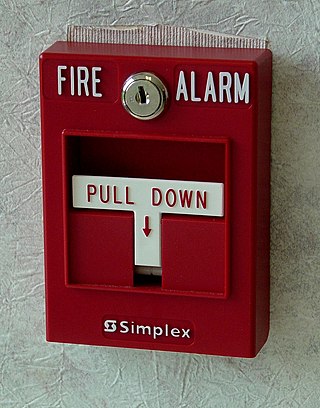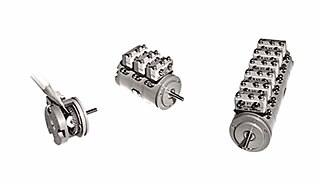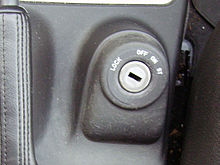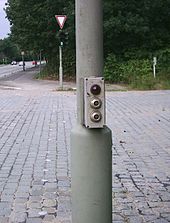
The technology of computer keyboards includes many elements. Among the more important of these is the switch technology that they use. Computer alphanumeric keyboards typically have 80 to 110 durable switches, generally one for each key. The choice of switch technology affects key response and pre-travel. Virtual keyboards on touch screens have no physical switches and provide audio and haptic feedback instead. Some newer keyboard models use hybrids of various technologies to achieve greater cost savings or better ergonomics.

A relay is an electrically operated switch. It consists of a set of input terminals for a single or multiple control signals, and a set of operating contact terminals. The switch may have any number of contacts in multiple contact forms, such as make contacts, break contacts, or combinations thereof.

Components of an electrical circuit are electrically connected if an electric current can run between them through an electrical conductor. An electrical connector is an electromechanical device used to create an electrical connection between parts of an electrical circuit, or between different electrical circuits, thereby joining them into a larger circuit. Most electrical connectors have a gender – i.e. the male component, called a plug, connects to the female component, or socket. The connection may be removable, require a tool for assembly and removal, or serve as a permanent electrical joint between two points. An adapter can be used to join dissimilar connectors.

A thermostat is a regulating device component which senses the temperature of a physical system and performs actions so that the system's temperature is maintained near a desired setpoint.

A combination lock is a type of locking device in which a sequence of symbols, usually numbers, is used to open the lock. The sequence may be entered using a single rotating dial which interacts with several discs or cams, by using a set of several rotating discs with inscribed symbols which directly interact with the locking mechanism, or through an electronic or mechanical keypad. Types range from inexpensive three-digit luggage locks to high-security safes. Unlike ordinary padlocks, combination locks do not use keys.

A safe is a secure lockable box used for securing valuable objects against theft or fire. A safe is usually a hollow cuboid or cylinder, with one face being removable or hinged to form a door. The body and door may be cast from metal or formed out of plastic through blow molding. Bank teller safes typically are secured to the counter, have a slit opening for dropping valuables into the safe without opening it, and a time-delay combination lock to foil thieves. One significant distinction between types of safes is whether the safe is secured to a wall or structure or if it can be moved around. A less secure version is usually called a cash-box.

A closure is a device used to close or seal a container such as a bottle, jug, jar, tube, or can. A closure may be a cap, cover, lid, plug, liner, or the like. The part of the container to which the closure is applied is called the finish.

Safe-cracking is the process of opening a safe without either the combination or the key.

A security alarm is a system designed to detect intrusions, such as unauthorized entry, into a building or other areas, such as a home or school. Security alarms protect against burglary (theft) or property damage, as well as against intruders. Examples include personal systems, neighborhood security alerts, car alarms, and prisons.

A remote keyless system (RKS), also known as remote keyless entry (RKE) or remote central locking, is an electronic lock that controls access to a building or vehicle by using an electronic remote control (activated by a handheld device or automatically by proximity). RKS largely and quickly superseded keyless entry, a budding technology that restrictively bound locking and locking functions to vehicle-mounted keypads.

Manual fire alarm activation is the process of triggering a fire alarm through a call point, pull station, or other device. This usually causes the alarm to sound the evacuation signal for the relevant building or zone. Manual fire alarm activation requires human intervention, as distinct from automatic fire alarm activation such as that provided through the use of heat detectors and smoke detectors. It is, however, possible for call points/pull stations to be used in conjunction with automatic detection as part of the overall fire detection and alarm system. Systems in completed buildings tend to be wired in and include a control panel. Wireless activators are common during construction.

An interlock is a feature that makes the state of two mechanisms or functions mutually dependent. It may be used to prevent undesired states in a finite-state machine, and may consist of any electrical, or mechanical devices or systems. In most applications, an interlock is used to help prevent any damage to the machine or to the operator handling the machine. Elevators are equipped with an interlock that prevents the moving elevator from opening its doors, and prevents the stationary elevator from moving. Interlocks may include sophisticated elements such as curtains of infrared beams, photodetectors, simple switches, and locks. It can also be a computer containing an interlocking computer program with digital or analogue electronics.
Intrinsic safety (IS) is a protection technique for safe operation of electrical equipment in hazardous areas by limiting the energy, electrical and thermal, available for ignition. In signal and control circuits that can operate with low currents and voltages, the intrinsic safety approach simplifies circuits and reduces installation cost over other protection methods. Areas with dangerous concentrations of flammable gases or dust are found in applications such as petrochemical refineries and mines. As a discipline, it is an application of inherent safety in instrumentation. High-power circuits such as electric motors or lighting cannot use intrinsic safety methods for protection.

Tamperproofing, conceptually, is a methodology used to hinder, deter or detect unauthorised access to a device or circumvention of a security system. Since any device or system can be foiled by a person with sufficient knowledge, equipment, and time, the term "tamperproof" is a misnomer unless some limitations on the tampering party's resources is explicit or assumed.

NEMA connectors are power plugs and receptacles used for AC mains electricity in North America and other countries that use the standards set by the US National Electrical Manufacturers Association. NEMA wiring devices are made in current ratings from 15 to 60 amperes (A), with voltage ratings from 125 to 600 volts (V). Different combinations of contact blade widths, shapes, orientations, and dimensions create non-interchangeable connectors that are unique for each combination of voltage, electric current carrying capacity, and grounding system.

A pressure switch is a form of switch that operates an electrical contact when a certain set fluid pressure has been reached on its input. The switch may be designed to make contact either on pressure rise or on pressure fall. Pressure switches are widely used in industry to automatically supervise and control systems that use pressurized fluids.
Silicone rubber keypads are used extensively in both consumer and industrial electronic products as a low cost and reliable switching solution.

A computer keyboard is a peripheral input device modeled after the typewriter keyboard which uses an arrangement of buttons or keys to act as mechanical levers or electronic switches. Replacing early punched cards and paper tape technology, interaction via teleprinter-style keyboards have been the main input method for computers since the 1970s, supplemented by the computer mouse since the 1980s.

Cam switches are mainly used within the low voltage range. On a shaft, switching cams are made of abrasion-resistant conductive material. By rotating the shaft, the contacts are opened or closed by the cams. Often, a plurality of cams are seated on a shaft, which simultaneously switch or switch several pairs of contacts.





















